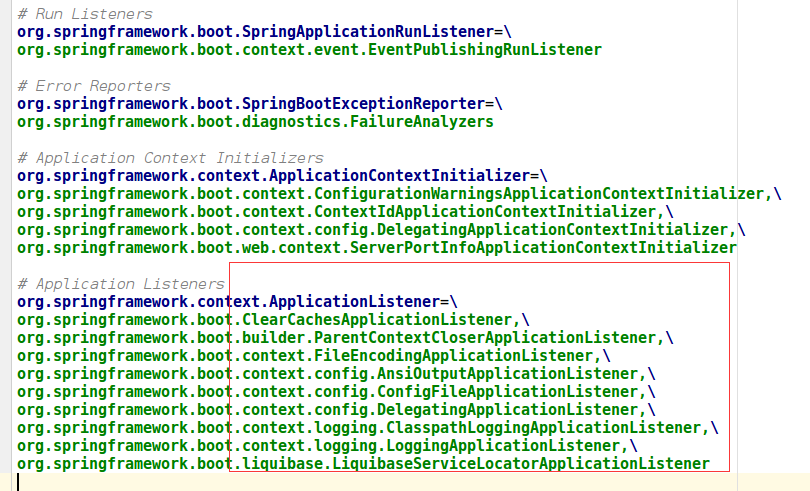您好,登錄后才能下訂單哦!
您好,登錄后才能下訂單哦!
本篇內容介紹了“Springboot中AbstractApplicationEventMulticaster有什么作用”的有關知識,在實際案例的操作過程中,不少人都會遇到這樣的困境,接下來就讓小編帶領大家學習一下如何處理這些情況吧!希望大家仔細閱讀,能夠學有所成!
Springboot的版本2.0.9.release,對應的SpringFramework值5.0.x.release。
AbstractApplicationEventMulticaster并不是Springboot里面的,而是屬于SpringFramework的。

圖1
如上圖1所示,AbstractApplicationEventMulticaster繼承了BeanFactoryAware,用于獲取BeanFactory;ApplicationEventMulticaster則包含增加、刪除ApplicationListener的接口方法,支持對象和String類型的bean名稱。
一開始以為AbstractApplicationEventMulticaster應該有個List<ApplicationListener>的屬性用于存放加入其中的ApplicationListener,但是看了源碼之后,發現Spring考慮的更周全、考慮的情況更多。
List-1
public abstract class AbstractApplicationEventMulticaster implements ApplicationEventMulticaster, BeanClassLoaderAware, BeanFactoryAware {
private final AbstractApplicationEventMulticaster.ListenerRetriever defaultRetriever = new AbstractApplicationEventMulticaster.ListenerRetriever(false);
final Map<AbstractApplicationEventMulticaster.ListenerCacheKey, AbstractApplicationEventMulticaster.ListenerRetriever> retrieverCache = new ConcurrentHashMap(64);
@Nullable
private ClassLoader beanClassLoader;
@Nullable
private BeanFactory beanFactory;
private Object retrievalMutex;
...
private class ListenerRetriever {
public final Set<ApplicationListener<?>> applicationListeners = new LinkedHashSet();
public final Set<String> applicationListenerBeans = new LinkedHashSet();
private final boolean preFiltered;
public ListenerRetriever(boolean preFiltered) {
this.preFiltered = preFiltered;
}
...如上的List-1,ListenerRetriever中的LinkedHashSet,才是真正存放ApplicationListener的地方。而retrieverCache則是用于作為緩存,為什么要做緩存,是因為我們丟給AbstractApplicationEventMulticaster的Event不一定會被發送,只有找到能支持這種Event的ApplicationListener才會進行發送。
首先來看下addApplicationListener,如下List-2,如果是ApplicationListener的實例,則加入到defaultRetriever的Set中,如果是String類型的beanName,則加入到defaultRetriever的applicationListenerBeans中,最后都調用retrieverCache的clear方法,retrieverCache是個線程安全的Map,因為新加入了ApplicationListener,所以我們需要更新我們的緩存。
List-2
public void addApplicationListener(ApplicationListener<?> listener) {
synchronized(this.retrievalMutex) {
Object singletonTarget = AopProxyUtils.getSingletonTarget(listener);
if (singletonTarget instanceof ApplicationListener) {
this.defaultRetriever.applicationListeners.remove(singletonTarget);
}
this.defaultRetriever.applicationListeners.add(listener);
this.retrieverCache.clear();
}
}
public void addApplicationListenerBean(String listenerBeanName) {
synchronized(this.retrievalMutex) {
this.defaultRetriever.applicationListenerBeans.add(listenerBeanName);
this.retrieverCache.clear();
}
}
...來看retrieveApplicationListeners方法的實現,這個很重要,因為發送Event之前,會先檢索出支持這種event的ApplicationListener。如下所示List-3:
遍歷applicationListeners,調用supportsEvent方法,如果支持,加將當前的ApplicationListener加入到結果集中。
之后遍歷applicationListenerBeans,先從BeanFactory中獲取對應的ApplicationListener實例,如果BeanFactory中含有對應的ApplicationListener,且supportsEvent方法返回true,那么將當前的ApplicationListener加入到結果集中。
最后調用AnnotationAwareOrderComparator進行排序。
List-3
private Collection<ApplicationListener<?>> retrieveApplicationListeners(ResolvableType eventType, @Nullable Class<?> sourceType, @Nullable AbstractApplicationEventMulticaster.ListenerRetriever retriever) {
List<ApplicationListener<?>> allListeners = new ArrayList();
LinkedHashSet listeners;
LinkedHashSet listenerBeans;
synchronized(this.retrievalMutex) {
listeners = new LinkedHashSet(this.defaultRetriever.applicationListeners);
listenerBeans = new LinkedHashSet(this.defaultRetriever.applicationListenerBeans);
}
Iterator var7 = listeners.iterator();
while(var7.hasNext()) {
ApplicationListener<?> listener = (ApplicationListener)var7.next();
if (this.supportsEvent(listener, eventType, sourceType)) {
if (retriever != null) {
retriever.applicationListeners.add(listener);
}
allListeners.add(listener);
}
}
if (!listenerBeans.isEmpty()) {
BeanFactory beanFactory = this.getBeanFactory();
Iterator var15 = listenerBeans.iterator();
while(var15.hasNext()) {
String listenerBeanName = (String)var15.next();
try {
Class<?> listenerType = beanFactory.getType(listenerBeanName);
if (listenerType == null || this.supportsEvent(listenerType, eventType)) {
ApplicationListener<?> listener = (ApplicationListener)beanFactory.getBean(listenerBeanName, ApplicationListener.class);
if (!allListeners.contains(listener) && this.supportsEvent(listener, eventType, sourceType)) {
if (retriever != null) {
retriever.applicationListenerBeans.add(listenerBeanName);
}
allListeners.add(listener);
}
}
} catch (NoSuchBeanDefinitionException var13) {
}
}
}
AnnotationAwareOrderComparator.sort(allListeners);
return allListeners;
}AbstractApplicationEventMulticaster的子類,需要實現multicastEvent方法,我們來看下SimpleApplicationEventMulticaster是如何實現的。
如下List-4所示,默認情況下taskExecutor是null。
multicastEvent方法中調用父類的getApplicationListeners方法獲取支持Event的ApplicationListener,之后遍歷ApplicationListener,如果taskExecutor不是null,則交給Executor;否則逐個調用ApplicationListener的onApplicationEvent方法。
List-4
public class SimpleApplicationEventMulticaster extends AbstractApplicationEventMulticaster {
@Nullable
private Executor taskExecutor;
public void multicastEvent(ApplicationEvent event, @Nullable ResolvableType eventType) {
ResolvableType type = eventType != null ? eventType : this.resolveDefaultEventType(event);
Iterator var4 = this.getApplicationListeners(event, type).iterator();
while(var4.hasNext()) {
ApplicationListener<?> listener = (ApplicationListener)var4.next();
Executor executor = this.getTaskExecutor();
if (executor != null) {
executor.execute(() -> {
this.invokeListener(listener, event);
});
} else {
this.invokeListener(listener, event);
}
}
}
private void doInvokeListener(ApplicationListener listener, ApplicationEvent event) {
try {
listener.onApplicationEvent(event);
} catch (ClassCastException var6) {
String msg = var6.getMessage();
if (msg != null && !this.matchesClassCastMessage(msg, event.getClass())) {
throw var6;
}
}
}
...Springboot中SpringApplicationRunListener的默認實現有個EventPublishingRunListener,如下List-5所示
List-5
public class EventPublishingRunListener implements SpringApplicationRunListener, Ordered {
private final SimpleApplicationEventMulticaster initialMulticaster;
...
@Override
public void starting() {
this.initialMulticaster.multicastEvent(
new ApplicationStartingEvent(this.application, this.args));
}
@Override
public void environmentPrepared(ConfigurableEnvironment environment) {
this.initialMulticaster.multicastEvent(new ApplicationEnvironmentPreparedEvent(
this.application, this.args, environment));
}
...
@Override
public void started(ConfigurableApplicationContext context) {
context.publishEvent(
new ApplicationStartedEvent(this.application, this.args, context));
}
...如List-5中所示,Springboot啟動的不同階段,會傳不同的event實現給EventPublishingRunListener,而EventPublishingRunListener則用Delete委托模式,交給initialMulticaster去處理。當然,started、running、failed事件則交給ConfigurableApplicationContext去處理。
來看EventPublishingRunListener的構造方法如下List-6所示,從SpringApplication中獲取Listener,之后加入到SimpleApplicationEventMulticaster中,所以Springboot中的事件是先交給SpringApplicationRunListener,之后SpringApplicationRunListener再委托給ApplicationListener的實現類完成具體的。
List-6
public class EventPublishingRunListener implements SpringApplicationRunListener, Ordered {
private final SpringApplication application;
private final SimpleApplicationEventMulticaster initialMulticaster;
...
public EventPublishingRunListener(SpringApplication application, String[] args) {
this.application = application;
this.args = args;
this.initialMulticaster = new SimpleApplicationEventMulticaster();
for (ApplicationListener<?> listener : application.getListeners()) {
this.initialMulticaster.addApplicationListener(listener);
}
}
...ApplicationListener的實現類如下圖2

圖2
“Springboot中AbstractApplicationEventMulticaster有什么作用”的內容就介紹到這里了,感謝大家的閱讀。如果想了解更多行業相關的知識可以關注億速云網站,小編將為大家輸出更多高質量的實用文章!
免責聲明:本站發布的內容(圖片、視頻和文字)以原創、轉載和分享為主,文章觀點不代表本網站立場,如果涉及侵權請聯系站長郵箱:is@yisu.com進行舉報,并提供相關證據,一經查實,將立刻刪除涉嫌侵權內容。